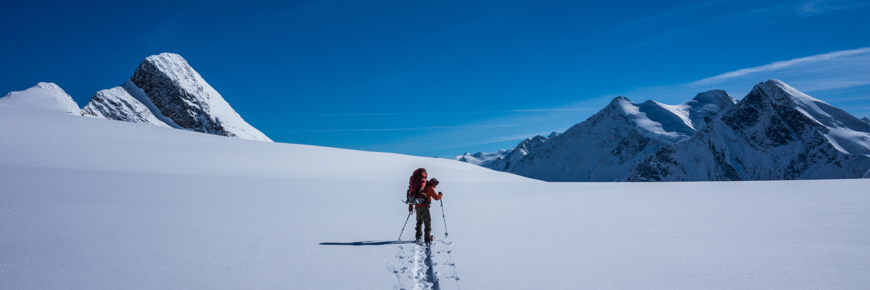
Ski touring in Rogers Pass, Glacier National Park
Photo: Eric Ricou
Backcountry ski touring and ski mountaineering
Mountain safety
Rogers Pass | The Rockies | Know before you go | Rescue services
It’s no secret – Canada’s Mountain National Parks are home to some of the planet’s most spectacular slopes and peaks to explore on skis or a splitboard, not to mention lay down a whole lot of fresh tracks.
Rogers Pass
Rogers Pass in Glacier National Park is known around the world as an unrivalled ski touring and ski mountaineering destination. In Rogers Pass, explosive artillery fire is regularly used on mountain slopes to protect highway and railway traffic from natural avalanches. The Winter Permit System separates skiers from artillery fire and the resulting avalanches. All of the mountain slopes that face the Trans-Canada Highway and railway corridor are part of the Winter Permit System. Much of this popular ski touring terrain may be closed daily for explosive avalanche control. You need to know where you can ski and ride to be safe from artillery fire.
The terrain in Rogers Pass is steep, serious and complex. By late November many of the higher slopes offer good skiing, but the snowpack many not yet offer solid bridges over crevasses on the glaciers. By season’s end the average snowpack is three to five metres.
Avalanche control work is conducted to keep the transportation corridor open, not to make slopes safe for skiers or boarders. Anyone travelling into the backcountry must have avalanche training and appropriate safety equipment.
The Rockies
In the Canadian Rockies, the cold dry snowpack is typically very weak and unstable during the early winter (December, January) and backcountry ski travel is usually poor at this time. Track skiing, downhill skiing at the lift-serviced ski areas and touring in the valley bottoms are all that can normally be recommended during this part of the season. The snowpack can normally be depended upon to provide a solid enough base to carry off track skiers by mid-February, but this is also when the larger avalanches of the season occur so careful route-finding is imperative on mountain trails and routes. The alpine touring season improves from March onward and is recommended in April and May on the icefields and snow peaks along the Continental Divide.
The Wapta Icefields straddling Banff and Yoho National Parks offer exceptional hut or tent-based glacier ski touring and peak bagging possibilities. The Wapta is wild and uncontrolled avalanche and glacier terrain. Do not venture on glaciated terrain unless everyone in your group is properly equipped and familiar with safe glacier travel and crevasse rescue techniques, and whiteout navigation skills.
Know before you go
If you haven’t yet, sign up for an Avalanche Skills Training Course to learn how to how to identify avalanche terrain, understand the conditions and factors that cause avalanches, plan and carry out a backcountry trip, carry out a companion rescue and use appropriate travel techniques when travelling in avalanche terrain. Before setting off on your trip, check the weather forecast, the Public Avalanche Forecasts and the Avalanche Terrain Exposure Scale. Don’t forget to check the winter backcountry checklist too. Don’t leave the trailhead unless everyone in your group is wearing an avalanche transceiver and carrying a shovel and probe, and knows how to use it. Practice often! Visit your nearest Beacon Basin. Be prepared to change your objectives as the conditions change – don’t allow yourself to become too fixated on a single destination just because it’s your only day off. And learn the emergency number for the Mountain National Park you plan to visit.
Like us on the Parks Mountain Safety Facebook page and @ParksMntSafety Twitter feeds for real time updates on road closures due to avalanche control.
For seasonal snow and ice conditions subscribe to the ACMG - Mountain Conditions Report.
Rescue services
Comprehensive rescue services are provided by Mountain Safety Program Specialists for visitors to the Mountain National Parks. Backcountry skiers and ski mountaineers, however, should plan on being self-reliant and remember that rescue assistance may not always be immediately available, especially during stormy weather. Rescue costs are normally recovered from the park user fees paid by visitors upon entry to the park.
- Date modified :